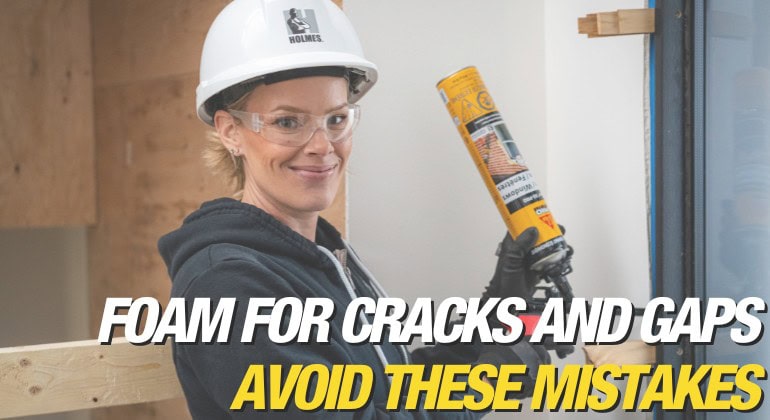I love my kitchen but it’s not large so it gets messy fast – add two growing young daughters, a husband and a cat – you have to stay organized....

How Do You Prevent Mold Growth?
By Mike Holmes
Mike’s Advice / Home Safety & Maintenance
Monday, March 18th, 2019 @ 12:58pm
Mold can present a serious health issue and it can also eat away at building materials, insulation and support structures. Areas in the home where mold tends to grow include the basement, bathrooms, walls, ceiling corners, the attic, crawlspaces and on windowsills. Mold grows in areas with a lot of moisture. This includes leaks in roofs, windows, or pipes, or where there has been flooding. It’s important to note that mold grows well on paper products, cardboard, ceiling tiles, and wood products. Mold can also grow in dust, paints, wallpaper, insulation, drywall, carpet, fabric, and upholstery. If you live somewhere humid, the garage can also be place for mold to thrive. When you do your seasonal maintenance make sure to check these areas for mold. So how do you prevent mold growth?
Mold growing in your home indicates that there is a problem with water or moisture. This is the first problem to address. It’s all about ventilation, taking care of your roof and inspecting your plumbing.
1. Ventilation In Kitchens and Bathroom To Prevent Mold
Your kitchen and bathroom need proper ventilation. They are the source of a lot of moisture in your home and this moisture can end up in your walls, floors, ceiling and attic. Exhaust fans pull air from inside your home and push it outside. The air shouldn’t be going into the attic, behind a wall, in the ceiling, crawlspace or anywhere else. It should only be going directly outside.
THE FIX
Always run the exhaust fan when cooking or taking a shower and at least 20-30 minutes after. If you don’t have a fan, install one. Also, after showering wipe up excess water and draw the curtain closed so it dries. If relative indoor humidity is consistently high consider investing in a dehumidifier.
TISSUE TEST: If your exhaust fan seems weak, do the tissue test. Turn your exhaust fan on—could be the one in the kitchen or bathroom—and hold a tissue up to it. If the fan holds the tissue it’s probably fine—if not, you might need to replace the fan. If any of your exhausts fail the tissue test bring in an HVAC pro.

Built-in Pick-A-Flow™ speed selector switch allows you to select your required airflow (110-130-150 CFM).
Without proper ventilation, moisture can become trapped in the bathroom. This leads to the growth of mold/mildew spores and potentially damaging paint, wallpaper, floors and metal fixtures. On our jobs, we have been installing the Panasonic Energy Star® Certified Whisper ventilation fans. Great quality.
Look into the airflow rating, noise level and energy efficiency of the bathroom ventilation fan you are installing. Your exhaust fan should be able to replace the air in a bathroom 8 times per hour. A large bathroom with will require a larger fan than a small two-piece bathroom.

Ventilating your bathroom with the proper ventilation fan will exhaust excess moisture and keep it drier.
2. Attic Ventilation To Prevent Mold
Most of a home’s moist air is expelled through the attic due to what’s called the stack effect, which is when warm air rises and is then sucked out of a rooftop opening and replaced by cooler air. When attic ventilation is lacking, humidity accumulates and can cause mold to grow on materials like wood framing, insulation, drywall and paint finishes.
THE FIX
Open gable vents and clear any obstructions from soffit vents. If your attic-vent opening is too small, increase it by asking your contractor to add soffit and ridge vents.
- Ridge Vent
- Gable Vent
- Roof Vent
- Bathroom Vent
- Soffit Vent
3. Your Roof and Mold
Screwed-in strips of flashing (usually rubber or sheet metal), along with roof shingles and siding channel water away from chimneys, vent stacks, dormers, skylights, windows and doors. But if the flashing doesn’t lie flush against a seam, water can seep in underneath leading to mold growth and structural damage.
THE FIX:
Take a look at the flashing on your roof after a bad storm to make sure it’s intact. Inspect places where the garage meets the house, where windowsills join siding, and wherever roof lines meet and dip into valleys. If the flashing has become loose contact a professional roofing contractor to inspect your roof and make any necessary repairs.
4. Fix Leaky Plumbing To Prevent Mold Growth
Even small leaks can lead to mold – and under-sink drain traps, shut-off valves, and underneath toilet tanks are common trouble zones. If the base of a vanity cabinet is saturated or warped you might have a leak in the plumbing or a clog that is causing a leak.
RELATED
THE FIX:
Contact a licensed plumber to tighten the large slip-joint nuts that keep drains clog-free. Stop leaky shutoff valves by backing one off slightly, or gently turning it clockwise if it’s open too wide. Otherwise, call the plumber for a replacement.
5. Keep Humidity Levels Low To Prevent Mold Growth
An air conditioner or dehumidifier will help you keep the level of humidity low. You can use a moisture meter or hygrometer, which is a digital device that measures air’s water-vapor content. A home’s relative humidity should be within the 30 to 50 percent relative humidity (RH) range.
Here is what you need to know about humidity and your house.

Be sure your home has enough ventilation. Use exhaust fans that vent outside your home in the kitchen and bathroom. Make sure your clothes dryer vents outside your home.
Tips to Prevent Mold Growth
- Address leaks in the foundation as soon as possible. If it’s a small crack, you can use an Injection Repair Kit like SikaFix (Watch the video below this list for the SikaFix Kit video)
- Look out for condensation, wet spots and signs of moisture. This should be part of your seasonal maintenance checklist.
- Increase air circulation to increase surface temperature.
- Increase ventilation (if outside air is cold and dry) or dehumidify (if outdoor air is warm and humid) to reduce the moisture level in the air. An ERV is great for controlling moisture.
- Keep heating, ventilation and air-conditioning drip pans clean and unobstructed.
- Make sure moisture-generating appliances, like dryers, are venting outdoors, not into the attic, garage or a wall cavity.
- Keep up with regular building/HVAC maintenance and inspections.
- Keep shrubs and greenery away from foundation walls and make sure the ground is sloping away from the foundation. You don’t want water entering your home.
- Replace bad windows to double or triple pane, with Low E film, argon gas filled glazing and/or with insulating spacers between panes.
SikaFix Kit For Leaky Foundations
If you can see or smell mold, a health risk may be present. Don’t ignore mold issues in your home. Mold should be removed (no matter what color it is) and the moisture source that helped it grow should be removed.
READ NEXT:









